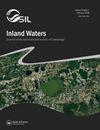斑马贻贝入侵后富营养化湖泊底栖生物群落的早期变化
IF 2.3
3区 环境科学与生态学
Q1 LIMNOLOGY
引用次数: 8
摘要
摘要在依赖于环境的生物入侵世界中,生物学家很少了解传播和影响的一般模式。一个可能的例外是斑马贻贝(Dreissena polymorpha),它是一种入侵者,通过一种被称为“底栖生物”的生态系统工程过程,经常重组食物网。通过有效地消耗浮游植物,斑马贻贝可以增加湖泊底栖生物的光穿透和营养浓度,从而刺激底栖生物(植物海底生物)和大型无脊椎动物(动物海底生物)的生长。很少有研究监测这些底栖生物群落对入侵的反应。我们记录了斑马贻贝入侵富营养化的门多塔湖(美国威斯康星州)时,植物海底生物和动物海底生物的早期变化。从2015年到2018年,斑马贻贝个体的数量达到了30只以上 000 m−2,在大型植物床中为3000 m−2。群落数据显示了典型的底栖生物迹象,包括(非斑马贻贝)动物底栖生物和植物底栖生物的丰度在深度梯度上平均增加300%,包括斑马贻贝定居深度的显著增加。深层大型植物生物量增加了900%,但水质澄清度没有明显的快速增加。我们推测,对于门多塔湖的海底反应,营养物质富集可能比光穿透增加更重要。将底栖生物的生产和过程继续纳入我们对湖泊生态系统的研究,对于理解整个生态系统的功能至关重要,尤其是当斑马贻贝继续在其入侵范围内“底栖”湖泊时。本文章由计算机程序翻译,如有差异,请以英文原文为准。
Early changes in the benthic community of a eutrophic lake following zebra mussel (Dreissena polymorpha) invasion
ABSTRACT In the context-dependent world of biological invasions, biologists understand few general patterns of spread and impact. One possible exception is the zebra mussel (Dreissena polymorpha), an invader that routinely restructures food webs through an ecosystem engineering process termed “benthification.” By efficiently consuming phytoplankton, zebra mussels can increase light penetration and nutrient concentrations in the benthos of a lake, thereby stimulating growth of benthic periphyton (phytobenthos) and macroinvertebrates (zoobenthos). Few studies monitor the response of these benthic communities to invasion. We documented early changes in phytobenthos and zoobenthos as zebra mussels invaded eutrophic Lake Mendota (Wisconsin, USA). From 2015 to 2018, the number of zebra mussel individuals reached densities >30 000 m−2 on hard substrates and 3000 m−2 in macrophyte beds. Community data showed classic signs of benthification, including 300% increases in (non-zebra mussel) zoobenthos and phytobenthos abundance on average across a depth gradient, including significant increases at depths where zebra mussels did colonize. Deep macrophyte biomass increased 900%, but water clarity showed no significant rapid increase. We speculate that nutrient enrichment may be more strongly responsible than increased light penetration for the benthic response of Lake Mendota. Continued integration of benthic production and processes into our study of lake ecosystems will be critical to understanding whole ecosystem function, especially as zebra mussels continue to “benthify” lakes within their invaded range.
求助全文
通过发布文献求助,成功后即可免费获取论文全文。
去求助
来源期刊

Inland Waters
LIMNOLOGY-MARINE & FRESHWATER BIOLOGY
CiteScore
6.10
自引率
9.70%
发文量
34
审稿时长
>12 weeks
期刊介绍:
Inland Waters is the peer-reviewed, scholarly outlet for original papers that advance science within the framework of the International Society of Limnology (SIL). The journal promotes understanding of inland aquatic ecosystems and their management. Subject matter parallels the content of SIL Congresses, and submissions based on presentations are encouraged.
All aspects of physical, chemical, and biological limnology are appropriate, as are papers on applied and regional limnology. The journal also aims to publish articles resulting from plenary lectures presented at SIL Congresses and occasional synthesis articles, as well as issues dedicated to a particular theme, specific water body, or aquatic ecosystem in a geographical area. Publication in the journal is not restricted to SIL members.
 求助内容:
求助内容: 应助结果提醒方式:
应助结果提醒方式:


